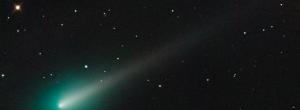Apr 16 2014
The Minor Planet Center, located at the Smithsonian Astrophysical Observatory (SAO) in Cambridge, Mass., has announced the recipients of the 2013 Edgar Wilson Award for the discovery of comets by amateurs. This is the fifteenth consecutive year that these Awards have been given.
 Comet ISON was discovered by two amateur astronomers in 2012. Despite high anticipation, it fizzled and broke apart while making its first pass around the Sun. Credit: Adam Block/Mount Lemmon SkyCenter/University of Arizona
Comet ISON was discovered by two amateur astronomers in 2012. Despite high anticipation, it fizzled and broke apart while making its first pass around the Sun. Credit: Adam Block/Mount Lemmon SkyCenter/University of Arizona
Money for the Awards was set aside as part of the will bequeathed by the late businessman Edgar Wilson of Lexington, Kentucky, and administered by the SAO. This year a total of $42,000 will be distributed among the recipients.
For most amateur astronomers, the historical naming of the comet for them has more meaning than any award, but the bestowment of the Edgar Wilson Award gives extra prestige and notice to their effort. Amateur comet discoverers usually put in long hours observing, with no financial aid, unlike the professional astronomers who discover most comets nowadays via surveys with large telescopes. Automated CCD searches with large professional telescopes have dominated comet discovery since 1998, so the contributions of amateurs deserve special recognition.
There have been numerous comet awards over the centuries, but the Wilson Award is currently the largest publicly known award.
The following seven discoverers will receive plaques and a cash award:
- Paulo Holvorcem of Porto Seguro, Brazil, and Michael Schwartz of Nogales, Arizona, for their joint discovery of six comets: P/2012 TK8, P/2012 WX32, C/2013 C2, C/2013 D1, P/2013 EW90, and C/2013 G9
- Masuyuki Iwamoto of Tokushima-ken, Japan, for his discovery of comet C/2013 E2
- Artyom Novichonok of Kondopoga, Russia, and Vitali Nevski of Vitebsk, Belarus, for their joint discovery of comet C/2012 S1 (ISON)
- Claudine Rinner of Ottmarsheim, France, for her discovery of three comets: P/2011 W2, C/2012 CH17, and P/2013 CE31M
- Tomas Vorobjov of Bratislava, Slovak Republic, for his discovery of comet P/2012 T7
This is the third Wilson Award for Holvorcem, and the second for both Schwartz and Novichonok.
The sun-grazing comet ISON (C/2012 S1), in particular, made a big splash in the media for its potential to become stunningly bright in early December. Unfortunately, ISON didn't survive its brush past the Sun on November 28th.
In years when there are no eligible comet discoverers, the Award is made instead to amateur astronomers judged by the Minor Planet Center to have made important contributions toward observing comets or promoting an interest in the study of comets.
Headquartered in Cambridge, Mass., the Harvard-Smithsonian Center for Astrophysics (CfA) is a joint collaboration between the Smithsonian Astrophysical Observatory and the Harvard College Observatory. CfA scientists, organized into six research divisions, study the origin, evolution and ultimate fate of the universe.